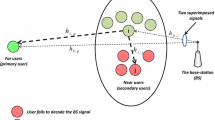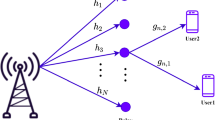Abstract
The capacity and spectral efficiency of the Cognitive Radio Networks (CRNs) are to be enhanced with Non-Orthogonal Multiple Access (NOMA) for Next-Generation (5G) communications that have been investigated. This paper has been examined in two phases. In the first phase, a dedicated base station through NOMA transmits a mixed/or superposed coded message signal to a primary user (PU) and a bunch of multiple secondary users (SUs). The selection of best SU from the bunch of SUs through the decode-and-forward approach, then it will act as a relay for further communication, and to make a system cooperative has been completed during the second phase. The outage probabilities of SUs and PU are being derived through closed-form representation and compared over orthodox multiple access technique. Results are simulated, analyzed and verified through the simulations of Monte-Carlo.
Access provided by Autonomous University of Puebla. Download conference paper PDF
Similar content being viewed by others
Keywords
1 Introduction
In a couple of years, Non-Orthogonal Multiple Access (NOMA) being the center of attraction for the researcher to facilitate multiple users in powdered form on the same time/frequency bands to improve the spectral efficiency of 5G communication over orthodox Orthogonal Multiple Access (OMA) in CRNs [4, 6, 8, 13].
Usually, the signal received at the destination through direct and indirect path is combined with the utilization of space diversity to mitigate various impairment [9, 11] of channel. Relays are used to create an indirect route. These relays are dedicated and user-oriented. The relays which standalone and not been selected by among users are known as dedicated relays. Outage probability of two users and relay selection by two-stage techniques are examined through a dedicated relays Cooperative NOMA (CNOMA) [2, 7, 14]. However, in the ad hoc network, installation of dedicated relays is robust and sophisticated. The user-oriented relays are utilized among users. In this case, users are being used as relays to improve the reliability of transmission for weaker channel gains user because more energetic gain users decode the other users signal through Successive Interference Cancellation (SIC) [3, 12]. Moreover, in relay processing, all available users can participate and enhanced processing complexity on SIC and through the grouping of (far and near) users with near user act as a relay for away user [1, 5].
The left of the paper is sorted as Sect. 2 presents a CNOMA-based CRNs system model. The examination of performance is to be done in Sect. 3. Sections 4 and 5 illustrate the discussion of results and conclusion, respectively.
2 System Model
Taking a downlink underlay, NOMA-based CRNs with a base station (BS) which unicast/multicast the multiplexed signal to a primary user (PU) and a bunch of (N) secondary users (SUs) in the first slot, respectively. During the second slot of time, all SUs have decoded their signals utilizing Successive Interference Cancellation (SIC). Best SU \((n^{*})\) is being selected which further act as a relay to retransmits the remaining signal to PU. Both the signal is reached to PU (from BS as well as best SU), and the best signal is to be selected through selection combining techniques (Fig. 1).
In first slot of time, the multiplexed signal at BS is defined as \({x_b ={{a}_{p}}{{x}_{p}}+{{a}_{s_n}}{{x}_{s_n}}}\) aired to PU and multiple SUs with unit power, where \({x}_{p}\) and \({x}_{s_n}\) are signal of PU and N SUs, respectively. \({a}_{p}\) and \({a}_{s_n}\) are the corresponding power coefficient with \({a}_{s_n}<{a}_{p}\) and \({{a}^{2}_{s_n}} + {{a}^{2}_{p}}=1\), i.e. \(n\in (1,2,\ldots N)\). Thus, the signal observed at PU and n SUs is expressed as
where \({P_{\mathrm {BS}}}\) mentions the BS power, \({h_{b,i}}\) and \({w_{b,i}}\) interprets the channel coefficients and Gaussian noise [10, 15] between a BS and node i, i.e. \(i\in (p,s_n)\), respectively.
Therefore, the received Signal-to-Interference-plus-Noise-Ratio (SINR) at PU is written as
Meanwhile, SUs are decoding the high priority, i.e. PU signal first with integration of SIC at n SUs to detect PU signal is expressed as
and the SINR at n SUs can be derived as
where \(\rho \simeq \frac{{{P}_{\mathrm {BS}}}}{{{N}_{0}}} \simeq \frac{{{P}_{S_n}}}{{{N}_{0}}}\) is assumed without loss of generality.
In second phase, after decoding all SUs signal, then the best SU, i.e. \((s_{n^{*}})\) reencode and retransmit the remaining signal, i.e. \({x_{s_{n^{*}}} ={{a}_{p}}{{x}_{p}}}\) to PU. Thus, the signal observed at PU comprised as
and the corresponding SINR is represented as
The best relay or SU selection is to be completed by
3 Performance Evalution
3.1 Outage Probability of SUs
The SUs outage probability mathematically expressed as
where \(\tau _p = 2^{2C_{\mathrm {out},p}}-1\) and \(\tau _{s_n} = 2^{C_{\mathrm {out},{s_n}} }-1\) denote threshold SINR correspondingly associated with \(2C_{\mathrm {out},p}\) and \(C_{\mathrm {out},{s_n}}\) outage capacities of PU and n SUs, respectively.
Substituting all given values into (9) and rearranged as
After simplification, the expression is rearranged as
where \(\theta = \frac{\tau _p}{a_p^2 - \tau _p a_{s_n}^2}\) and \(\phi = \frac{\tau _{s_n}}{ a_{s_n}^2}\).
The above expression is concluded as
where \(\eta = \max \left( \theta ,\ \phi \right) \).
The pdf of \(f_{\left| h_{b,{s_{n}}} \right| ^2} \) due to order statistics can be given as
Further it can be simplified as
After solving above expression gives outage probability of SUs as
3.2 Outage Probability of PU
The outage probability of a PU is being calculated through
Taking
now taking
Generally, it can be written as
Substituting provided values into (15), gets
Therefore,
where \(\Phi _n = \frac{\tau _p}{a_p^{2}}\), pdf of \(P\left( {{\left| {{h}_{b,s_n}} \right| }^{2}}<\frac{\theta _n}{\rho } \right) = \mathrm {e}^{\frac{-\theta _n}{\rho }} \) and \(P\left( {{\left| {{h}_{s_n,{p}}} \right| }^{2}}<\frac{\Phi _n}{\rho } \right) = \mathrm {e}^{\frac{-\Phi _n}{\rho }}\), respectively.
Substituting (14) and (16) into (13), gets outage probability of a PU as
3.3 Outage Capacity of SUs
From (12) can be simplified for an SU is to be expressed as
At high \(\rho \), assumed \(\mathrm {e}^{x} = 1+x\) the expression can be modified as
The outage capacity of SUs depends on the value of \(\tau _{s_n}\), so that
Therefore, outage capacity of SUs is written as
3.4 Outage Capacity of PU
Similarly, from (17), expression can be rewritten as
where letting \(\left[ 1- \mathrm {e}^{\frac{- \theta }{\rho }} \right] =1\), \(\mathrm {e}^x = 1+x\) and \(\theta _n \gg \Phi _n\) at high \(\rho \).
For simplicity taking \(n=1\), the expression can be defined as
where \(\theta _n = \frac{\tau _p}{a_p^2 - \tau _p a_{s_n}^2}\).
Thus, the outage capacity of a PU for \(n=1\) is to be illustrated as
Now, outage sum capacity of given system is to be represented as
4 Results and Discussion
BS and PU lie at center (0, 0) and edge (1, 1) of the cell simultaneously, and N SUs are distributed in between them. The channel gain \(\lambda _{j,k} = d_{j,k}^{-\xi }\) with \(\xi = 3\) and \(d_{j,k}\) defines the path loss factor for urban areas and normalized distance between (j, k) nodes, respectively. Taking \(C_{\mathrm {out},p}= C_{\mathrm {out},{s_n}} = 0.5\) bps/Hz along with associated \(a_{p}^2 = 0.86\) and \(a_{s_n}^2 = 0.14\) coefficients.
Figure 2 shows the comparison between proposed CNOMA and orthodox OMA through DF technique of relaying in given CRNs. The related figure depicts the analyses results which are equal to the simulated solutions. Simultaneously, the proposed CNOMA provides outstanding behavior over OMA which is being offered in Fig. 2. Outage behavior of PU and SUs is continuously enhanced and reduced with the rising value of \(\rho \), respectively. The intersection point on outage probabilities curves of SUs and PU represents the approximate assignment powers to SUs (14%) and PU (86%) at (\(\rho = 10\,\mathrm {dB}\)) of the total system power, respectively. Therefore, PU behaves well than SU and OMA also, as given in Fig. 2.
The outage sum capacity of CNOMA and OMA has been depicted through Fig. 3 w.r.t. different values of \(\rho \). Moreover, outage capacity of PU under CNOMA is gradually enhanced initially then becomes constant along \(\rho \) due to presence of noise in the denominator as compared to OMA. The outage capacities of both PU and SUs increase along \(\rho \) under CNOMA but behaves much better than the existing orthodox OMA technique, as shown in Fig. 3. Thus, the outage sum capacity of CNOMA shows outstanding behavior over OMA.
5 Conclusion
This paper concludes that the outage probabilities and capacities of SUs, as well as a PU for the given CNOMA, outperform over orthodox OMA with implementing DF relaying technique in CRNs, respectively. The closed-form solutions of outage capacity and probabilities are also discussed along with the comparison of sum capacity of the system as mentioned earlier to OMA technique through simulation results.
References
Z. Ding, H. Dai, H.V. Poor, Relay selection for cooperative NOMA. IEEE Wirel. Commun. Lett. 5(4), 416–419 (2016)
Z. Ding, M. Peng, H.V. Poor, Cooperative non-orthogonal multiple access in 5g systems. IEEE Commun. Lett. 19(8), 1462–1465 (2015)
Z. Ding, Z. Yang, P. Fan, H.V. Poor, On the performance of non-orthogonal multiple access in 5g systems with randomly deployed users. IEEE Sig. Process. Lett. 21(12), 1501–1505 (2014)
M.S. Gupta, K. Kumar, Progression on spectrum sensing for cognitive radio networks: a survey, classification, challenges and future research issues. J. Netw. Comput. Appl. 143, 47–76 (2019)
J. He, Z. Tang, Low-complexity user pairing and power allocation algorithm for 5g cellular network non-orthogonal multiple access. Electron. Lett. 53(9), 626–627 (2017)
A. Kumar, K. Kumar, Multiple access schemes for cognitive radio networks: a survey. Phys. Commun. 38, 100953 (2020)
A. Kumar, K. Kumar, Relay sharing with DF and AF techniques in NOMA assisted cognitive radio networks. Phys. Commun., 101143 (2020)
A. Kumar, K. Kumar, M.S. Gupta, S. Kumar, A survey on NOMA techniques for 5g scenario. Available at SSRN 3573579 (2020)
S. Kumar, A.K.R.K. Jha, in Performance Analysis of Segmentation Using SSR Under Different Noise Conditions (IEEE, 2017), pp. 1–4
S. Kumar, R.K. Jha et al., in Characterization of Supra-Threshold Stochastic Resonance for Uniform Distributed Signal with Laplacian and Gaussian Noise (IEEE, 2017), pp. 1–4
S. Kumar, B. Panna, R.K. Jha, Medical image encryption using fractional discrete cosine transform with chaotic function. Med. Biol. Eng. Comput. 57(11), 2517–2533 (2019)
Y. Liu, Z. Ding, M. Elkashlan, H.V. Poor, Cooperative non-orthogonal multiple access with simultaneous wireless information and power transfer. IEEE J. Sel. Areas Commun. 34(4), 938–953 (2016)
B. Makki, K. Chitti, A. Behravan, M.S. Alouini, A survey of NOMA: current status and open research challenges. IEEE Open J. Commun. Soc. 1, 179–189 (2020)
J. Men, J. Ge, Performance analysis of non-orthogonal multiple access in downlink cooperative network. IET Commun. 9(18), 2267–2273 (2015)
S. Shourya, S. Kumar, R.K. Jha, in Adaptive Fractional Differential Approach to Enhance Underwater Images (IEEE, 2016), pp. 56–60
Author information
Authors and Affiliations
Editor information
Editors and Affiliations
Rights and permissions
Copyright information
© 2022 The Author(s), under exclusive license to Springer Nature Singapore Pte Ltd.
About this paper
Cite this paper
Kumar, A., Gupta, M.S., Kumar, K., Kumar, S. (2022). Utilization and Selection of Best SU Act as Relay via Cooperative NOMA (CNOMA)-Based CRNs for Next-Generation (5G) Communications. In: Dhawan, A., Tripathi, V.S., Arya, K.V., Naik, K. (eds) Recent Trends in Electronics and Communication. VCAS 2020. Lecture Notes in Electrical Engineering, vol 777. Springer, Singapore. https://doi.org/10.1007/978-981-16-2761-3_70
Download citation
DOI: https://doi.org/10.1007/978-981-16-2761-3_70
Published:
Publisher Name: Springer, Singapore
Print ISBN: 978-981-16-2760-6
Online ISBN: 978-981-16-2761-3
eBook Packages: EngineeringEngineering (R0)







